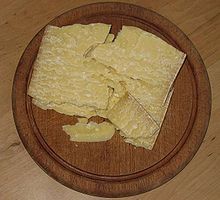| Sbrinz | |
|---|---|
 | |
| Country of origin | Switzerland |
| Region | Central Switzerland |
| Texture | hard and very hard |
| Fat content | 45% |
| Aging time | 24 to 30 months |
| Certification | AOC and AOP |
| | |
Sbrinz is a very hard cheese produced in Central Switzerland. It is often used as grated cheese in Swiss cuisine, although it is also eaten in small pieces. The cheese is produced in only 42 dairies in Central Switzerland. Only local cow's milk is used when producing this cheese. It is kept in the region until ready for consumption. It is the hardest of Swiss cheeses together with Berner Hobelkäse.
Contents
Sbrinz probably got its name from the town of Brienz in the Bernese Oberland. In the 16th and 17th centuries, there was a collecting point for both cheeses from the Oberland and Central Switzerland. Most of the cheese was then transported from there across the Alps. Customers in northern Italy soon named the cheese "Sbrinz" after this place. The term then also became common in Switzerland. A second explanation is based on the adoption of the Lombard dialect word "sbrinzo", a term for hard cheese. [1]

